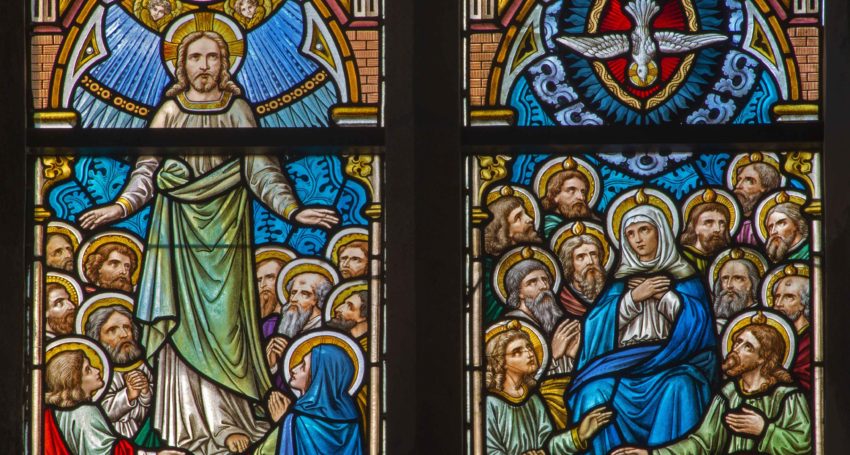The Ascension of Our Lord Jesus Christ
Features
“The Ascension points both to an event in history, the last resurrection appearance of Jesus to his disciples, and to the purpose of Jesus’ victory on the cross, the taking of our humanity to God. However, I think that we need to face up to some problems,” says The Ven. Keith Dean-Jones OGS

I always feel a bit uncomfortable with celebrating the Ascension of Our Lord, and I struggle to describe the event and understand its theological significance. The Feast Day is overshadowed by Easter, which is celebrated 40 days before the Ascension with Pentecost celebrated 10 days after the Ascension. In recent years, some Churches have observed the Feast on the Seventh Sunday of Easter, and this only seems to make it harder to recognise the significance of the Feast. We can end up thinking that “We observe the day because it is in the Prayer Book”, and for no other reason.
The Feast refers to events described at the end of the Gospel according to Luke (24.50-53), at the beginning of the Acts of the Apostles (1.9) and the ‘long ending’ of the Gospel according to Mark (16.19). the Gospel according to John the risen Christ assures Mary Magdalene that “he is ascending to my Father and your Father, to my God and your God” (John 20.17). There is no description of the actual event. Although there is little direct reference to Jesus’ resurrection in the Letter to the Hebrews, the principal theme of the book is the exaltation of the risen Lord. The Ascension affirms that, as Jesus has ascended “into the heavens so we may also in heart and mind thither ascend, and with him continually dwell” (The Collect for The Ascension Day, The Book of Common Prayer).
The Ascension points both to an event in history, the last resurrection appearance of Jesus to his disciples, and to the purpose of Jesus’ victory on the cross, the taking of our humanity to God. However, I think that we need to face up to some problems.
First, to some the Ascension may suggest that Heaven is located ‘above’ the earth. Seventeenth century ‘Muggletonians’ believed that Heaven was six miles above the surface of the earth and that, on a clear day and with good eyesight, it could be glimpsed. Christian iconography is not always helpful, and immediately above the altar in the Ascension Chapel of the Anglican Shrine of Our Lady of Walsingham the feet of the ascending Jesus protrude through a polystyrene cloud!
Advertisement
Secondly, we desire to celebrate Jesus’ presence, and not lament his absence. The Gospel according to Matthew has ‘book ends’. At the beginning of Matthew’s account there is a story of God revealing to Joseph in a dream that the unborn child of Mary will be ‘Emmanuel’, “God is with us” (Matthew 1.23). At the end of the Gospel, Jesus reassured the disciples with the declaration, “I am with you always, even to the end of the age” (Matthew 28.20). This presence is the gift of the Holy Spirit. In the Gospel according to John, the Spirit is poured out by the Father on the day of resurrection and it is in response to Jesus’ promise “I will ask the Father, and he will give you another Advocate to be with you forever” (John 14.16). But in the Gospel according to Luke, the Ascension is a prelude to the coming of the Holy Spirit on the Day of Pentecost “like the rush of a violent wind” (Acts 2.2).
The apostle Paul developed a theology of the Holy Spirit. Writing to the Romans he referred to the ‘Spirit of God’ as the ‘Spirit of Christ’ (8.9). The Holy Spirit does not replace the risen Lord for he is one with the risen Lord and the Father in the life of the Holy Trinity. The Ascension is located as an event in history, but it points to the central event of the Christian scriptures, the resurrection of Jesus, to the reality of his presence with those who are united to him in baptism and faith, and to the future hope of our transformation into his likeness.
Advertisement
Thirdly, the theological significance of his ‘going away’. Traditionally, we celebrate the Feast of the Ascension as a celebration of God taking our humanity to himself. God’s creation of our humanity is dynamic and not static, and we recognise that we are born human so that we may ‘become human’. Jesus, the Son of God and the Son of Mary, is fully God and fully human. This means that he not only reveals God but that he reveals what it means to be a man or a woman. His humanity is much more than a description of his physiology. He is the complete human being.
God has invested us with desire. The psalmist wrote “As a deer longs for the running brooks so longs my soul for you, O God” (Psalm 42.1), and St Augustine of Hippo commented “You have made us for Yourself and our hearts are restless until they rest in You” (Augustine Confessions 1). We desire to be with God and we desire to be alive to our humanity. To be human, we are challenged to die to selfishness and live with compassion and forgiveness for friends and neighbours. This is only partially achieved in this world and the aim of our lives is to become the person God has created us to be. In ascending into heaven, Jesus has gone before us so that, by the grace of his Holy Spirit, this process of ‘humanisation’ can be achieved.





